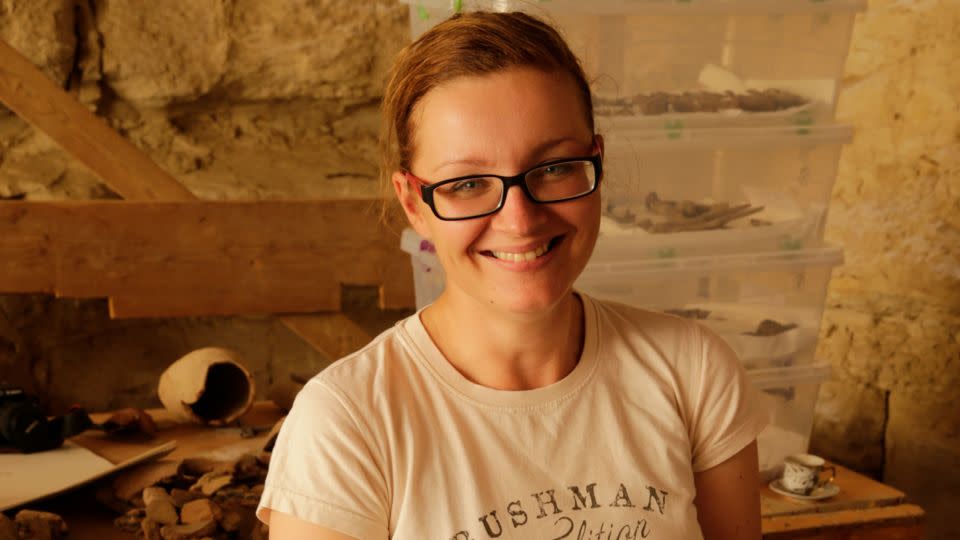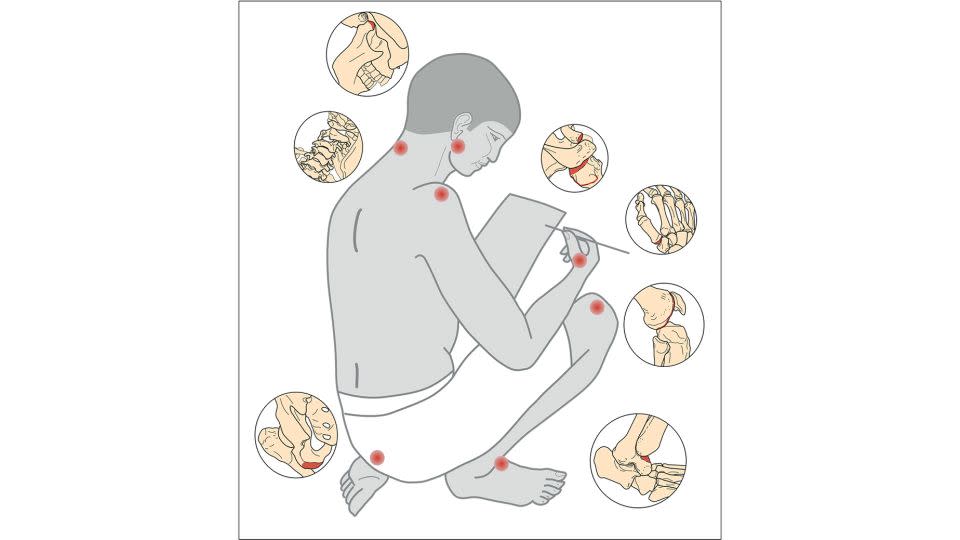Sign up for CNN’s Wonder Theory science newsletter. Explore the universe with news on fascinating discoveries, scientific advancements and more.
Performing administrative tasks in ancient Egypt may not sound physically demanding, but new research has revealed that being a scribe left a mark on the skeletons of the men who held those privileged positions.
Scribes were high-status men with the ability to write and were part of the 1% of the population that was literate, according to the authors of a new study published Thursday in the journal Scientific Reports.
But the tasks that scribes carried out were repetitive. Today, office workers seek ergonomically supportive chairs for long hours sitting at a desk. The Egyptian men assumed one of three positions that became an occupational hazard, the study authors found.
Researchers analyzed the remains of 69 men buried at a necropolis in Abusir, Egypt, between 2700 BC and 2180 BC. Thirty of the men were scribes, as marked on their tombs, and their skeletons had more degenerative joint changes within specific areas of their bodies than the other remains.
The findings open a new window into what life was like for scribes in ancient Egypt during the third millennium BC.
Becoming a scribe
The remains analyzed in the study belonged to men who lived in the heyday of ancient Egypt during the Old Kingdom, or the era of pyramid builders, said study coauthor Veronika Dulíková, an Egyptologist within the Czech Institute of Egyptology at Charles University in Prague.
Records from that time indicate to researchers that sons of elite families were educated at the royal court.
“At a very early age, in their teens, they enlisted to serve in entry-level positions in various administrative offices to gain the necessary training to further their careers,” Dulíková said in an email. “They then moved up the hierarchy of the offices they held.”
At the time, literacy was in its infancy, she said. “There was no need for a predominantly agricultural population to be able to read and write.”
Scribes in ancient Egypt worked positions not too dissimilar from government positions in modern society.
“These people belonged to the elite of the time and formed the backbone of the state administration,” Dulíková said. “Literate people worked in important government offices such as the treasury (today’s Ministry of Finance), the granary (today’s Ministry of Agriculture), the department of royal document, etc. They also played an important role in the collection of taxes, in temple cults and in royal pyramid complexes.”

The roles of the scribes were crucial in ancient Egyptian society, but the records they left behind have been even more valuable to researchers.
“The ancient Egyptians kept careful records of everything, which they then stored in archives,” Dulíková said. “When we find such a paper archive today, it is literally a treasure. From such records we can learn much about the functioning of the temple complexes, the services of the officials in the temples, the form of their salaries, what furniture or utensils were stored in the temple storehouses, etc.”
The Egyptians were so detailed that they included written records directly in the tombs to identify the positions, careers and ranks of the men buried there, which helped researchers identify the administrative scribes.
Skeletal clues
Lead study author Petra Brukner Havelková, an anthropologist at the National Museum in Prague, has specialized in identifying activity-induced skeletal markers for nearly 20 years.
When Havelková looked at the remains uncovered at Abusir and spotted examples of stress on the cervical spines, she realized there might be a connection between the skeletal degeneration and the men’s occupations.
The first skeletons of Old Kingdom people were uncovered in 1976 at Abusir, but it took decades to unearth more.
After being unable to find any research on degenerative joint and bone disease in ancient scribes, Havelková teamed up with Dulíková and other colleagues to conduct a study of their own. They began marking changes in scribe skeletons in 2009, but it took another decade to find enough remains for a comprehensive study.
During their analysis, the researchers discovered that the scribes had a higher incidence of osteoarthritis, or a disease where joint tissues break down over time.
These changes were observed in joints connecting the lower jaw to the skull, the right collarbone, the top of the upper right arm bone connected to the shoulder, the bottom of the thigh, right thumb bones and throughout the spine.
There were also noticeable changes, such as a flattened part of the bone on the lower part of the right ankle and indentations on both kneecaps.


Most of the skeletal changes could be traced to the positions scribes assumed as they carried out their work, which has been recorded on tomb wall decorations and in statues. Scribes either stood, kneeled or sat with their legs crossed for long periods of time as they wrote.
If they sat cross-legged, their stretched skirts served as a table, according to the researchers. In this position, they likely sat for hours, head bent forward with their arms unsupported and their spines flexed.
But skeletal changes in their knees, hips and ankles also point to a squatting or crouching position that many scribes preferred. It’s likely that the scribes sat with their left legs in a kneeling or crossed position, while their right legs were bent with the knees pointing upward.
A jaw joint surprise
The scribes also chewed the ends of the rush stems they used for writing implements to create brushlike heads that they spent hours holding in a pinchlike position.
The chewing explains why their jaws were overloaded, while long hours of writing likely caused the skeletal changes observed in their right thumbs, the researchers said.
The researchers were less surprised to find changes in the lower limbs because cross-legged sitting and kneeling were common among the entire population at the time, but they weren’t expecting the jaw changes.
“The biggest surprise was the extreme overloading of the jaw joints in the scribes,” Havelková said in an email. “This was something we hadn’t even hypothesized at first, focusing primarily on the rest of the skeleton outside the skull.”
Dr. Sonia Zakrzewski, a professor of bioarchaeology and bioanthropology at the University of Southampton in the United Kingdom, called the research “innovative.” She was not involved in the study.
“It synthesises both the Egyptological record (including the pictorial and sculptural evidence) with the bioarchaeological evidence of activity-related skeletal change to argue that the changes to muscle attachment sites and the location for arthritic change is suggestive of the individuals affected being scribes,” Zakrzewski said in an email.
“One of the key issues we have in bioarchaeology is that we do not know exactly how much, how long and/or how frequent activities have to be undertaken in order for skeletal change to occur — but we know that our bodies remodel in response to such strains. This integration of other aspects of archaeology with the skeletal record is needed in bioarchaeology and this study is a really nice example of that type of approach. “
Now, the researchers want to collaborate with other groups to study and analyze scribes and other individuals across different ancient Egyptian cemeteries, such as the burial site at Saqqara.
“Together with our ‘neighbours’ at Saqqara, we share a common goal, which is to learn as much as possible about the life, and death, of the people who lived in the time of the pyramid builders,” Havelková said.
For more CNN news and newsletters create an account at CNN.com
Source Agencies


